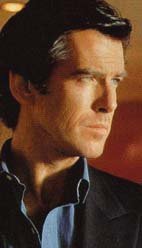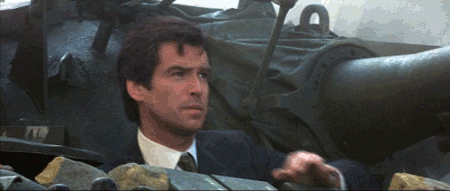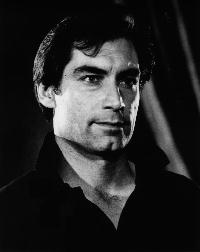|
THE
NINETIES
Legal
troubles kept Bond off movie screens for six years. It all started with the disappointing
North American grosses of Licence To Kill ($34 million
-- although it did gross over $150 million worldwide, breaking records in several
markets).
Nevertheless, in 1991 the next Bond film was being
planned. The title would be Portrait of a Lady, inspired by Fleming's The
Property of a Lady (the title was changed because it was repeatedly mentioned
in the film Octopussy). It would star Timothy
Dalton and Whoopi Goldberg, with the plot concerning the 1997 transfer of
Hong Kong from British to Communist control (a similar plot was later used by
Raymond Benson in the Bond book Zero Minus Ten).
In the February 10, 1988 issue of Variety, Kevin McClory
had announced plans for "James Bond vs. SPECTRE" - an animated TV series that
he would produce with an unnamed Dutch company. But that deal fizzled.
Eon
countered with James Bond, Jr. - an animated childrens'
show to attract a younger market than the Dalton films were reaching. And yes,
it was pretty bad.
But McClory tried again: He teamed up with Remington
Steele star Pierce Brosnan and his wife, former
Bond girl Cassandra Harris, to try yet another version of Warhead.
Brosnan said later: "My wife and I said, "Let's do this.' We found a Japanese
outfit with lots of money to make the movie. But dealing with the litigation and
the paperwork involved, it was enormous. And it went nowhere."
But in 1992,
McClory leased the TV rights for Bond to producer Al Ruddy (The Godfather)
of Ruddy/Morgan Productions. They announced a James Bond TV series -- a weekly
one hour show budgeted at $1.6 million an episode. It was to feature Brosnan's
Bond against SPECTRE in a post-cold war setting. Eon Productions sued, as usual.
Meanwhile, Eon was getting nowhere with their projected films. 'Twins' writers Will Davies and Will Osborne wrote two drafts of a screenplay for the aborted third Timothy Dalton James Bond film, which would have been released in the Autumn of 1991, based on the treatment by Michael G. Wilson and Alphonse Ruggiero, Jr., but the project was scrapped.
Then
Albert Broccoli became ill. (Possibly from reading that script.) First he had a heart attack, the eye problems (he died in 1996). At the same time, he was suing everyone. He filed suit against MGM/UA and Pathe
Communications (which was in the process of buying MGM/UA) to prevent Pathe owner
Giancarlo Paretti from selling the foreign television rights to the Bond films
for a greatly reduced rate, so that Pathe could take the money and complete the
MGM/UA buyout. Sound illegal? It probably was. Paretti was jailed in Italy for
tax evasion and sued by everyone that ever worked for him. Soon checks from MGM/UA
were bouncing all over town, and he was ousted from the company.
In
1993, MGM settled with Broccoli, paying him $13.5 million, and joining Broccoli
in his lawsuit against Al Ruddy. That was the end of the Bond TV series.
But
it was also the beginning of the next Bond movie. The article at left is from
Film Review in August of 1993.
MGM/UA was struggling to survive after
the Paretti disaster, and they hadn't had a blockbuster in a while. There hadn't
been a Bond film in five years, but the box office take on Licence
To Kill was poor, and MGM/UA blamed the low take on the relatively unknown Dalton. They wanted someone that was better known to US audiences - a TV star, like Roger
Moore had been.
Dalton, now the neighbor of the Broccolis in Los Angeles, had a contract to fulfil, and Cubby wanted Dalton to continue in the role. But an ultimatum was put to Eon: "No new actor, no financing. We want Pierce
Brosnan."
The Broccolis were aghast that after five years of contract problems,
another legal battle was looming on the horizon.
But by 1994, Timothy
Dalton was sick of Bond. Now in his 50's, tiring of the Moore and
Connery comparisons, and the stunts-first direction the series had taken under John Glen, he waffled on the project and opted to try an even more difficult re-interpretation: Rhett Butler in the Gone With The Wind sequel, Scarlett. Cubby and
Timothy discussed the situation, and Dalton was sent the script to GoldenEye
on the set of Scarlett. But Dalton passed on the role. In a press release
from the set, he announced that he was through with 007. He also noted that his
three-picture deal ended with Eon in 1990, and he gladly would've done another
one if not for the legal delays.
 |
Enter
Pierce Brosnan, who had spent ten years grumbling about
his missed opportunities to play Bond in The Living Daylights,
and in the various McClory projects. He had reportedly been Roger
Moore's choice to replace him in the role (which was a ridiculous rumor -
Moore thought he should be in the role, not somebody else).
Bond fans began to worry: Brosnan's show, Remington Steele,
was not critically praised by any stretch of the imagination, and Brosnan himself
played a sanitized Roger Moore-like character who would rather talk his way out of a situation than fight.
But Brosnan had by his own admission used the ten years to improve his acting skills, and he was no longer considered just a Moore clone. But Bond fans could only brace themselves and hope for the best...
Meanwhile, like a devious Blofeld (at least to EON), Kevin McClory kept plotting
and biding his time. This time he had more help -- Sony, a bigger studio than
MGM/UA -- and an actor named Sean Connery...

FILM PROJECTS OF THE NINETIES
James Bond, Jr.
Bond 17 (Unproduced treatment by Michael G. Wilson and Alphonse Ruggiero, Jr.)
GoldenEye
Tomorrow Never Dies
The World is not Enough
 Main Page
Main Page

Return
to COMEDY ON TAP
|






